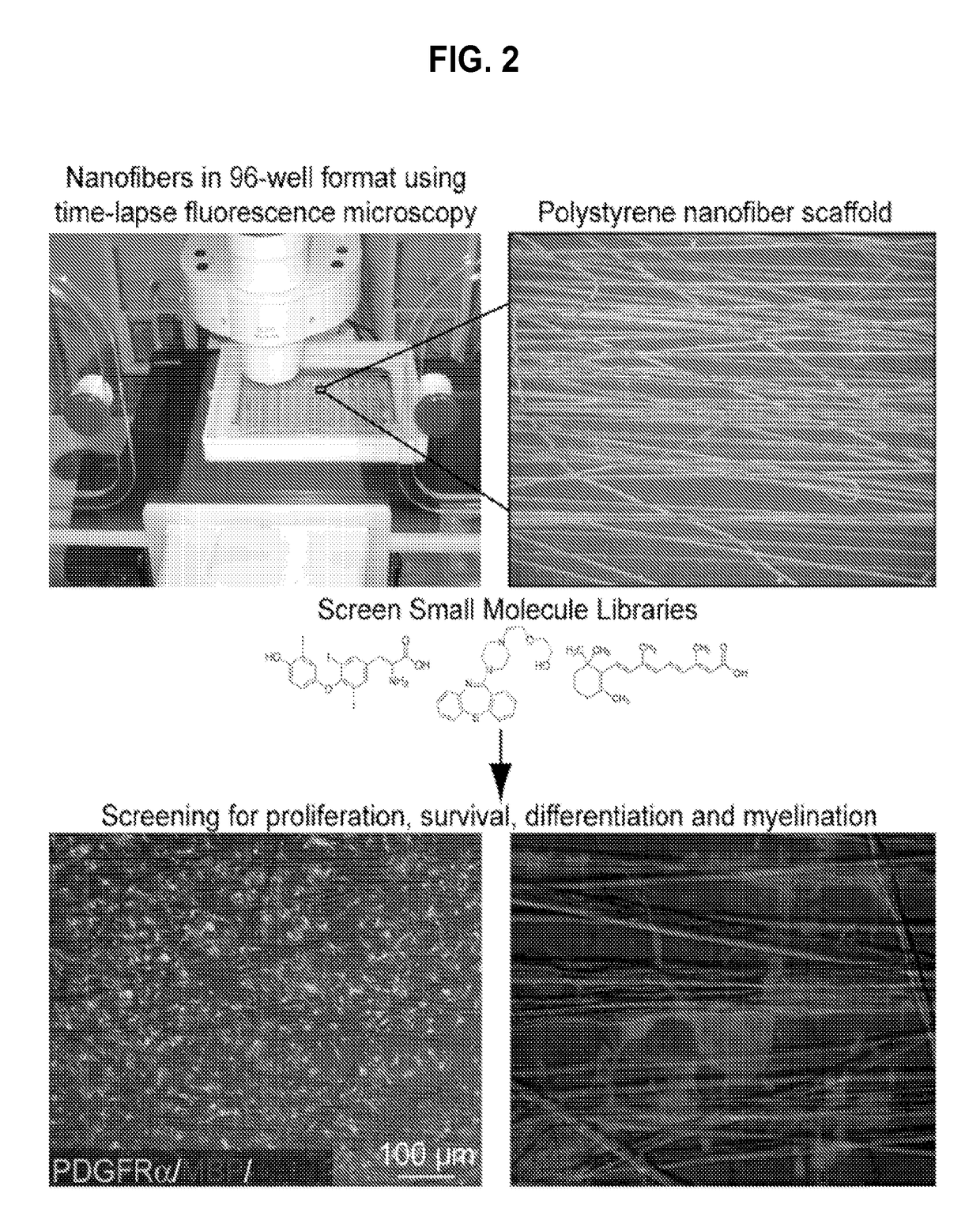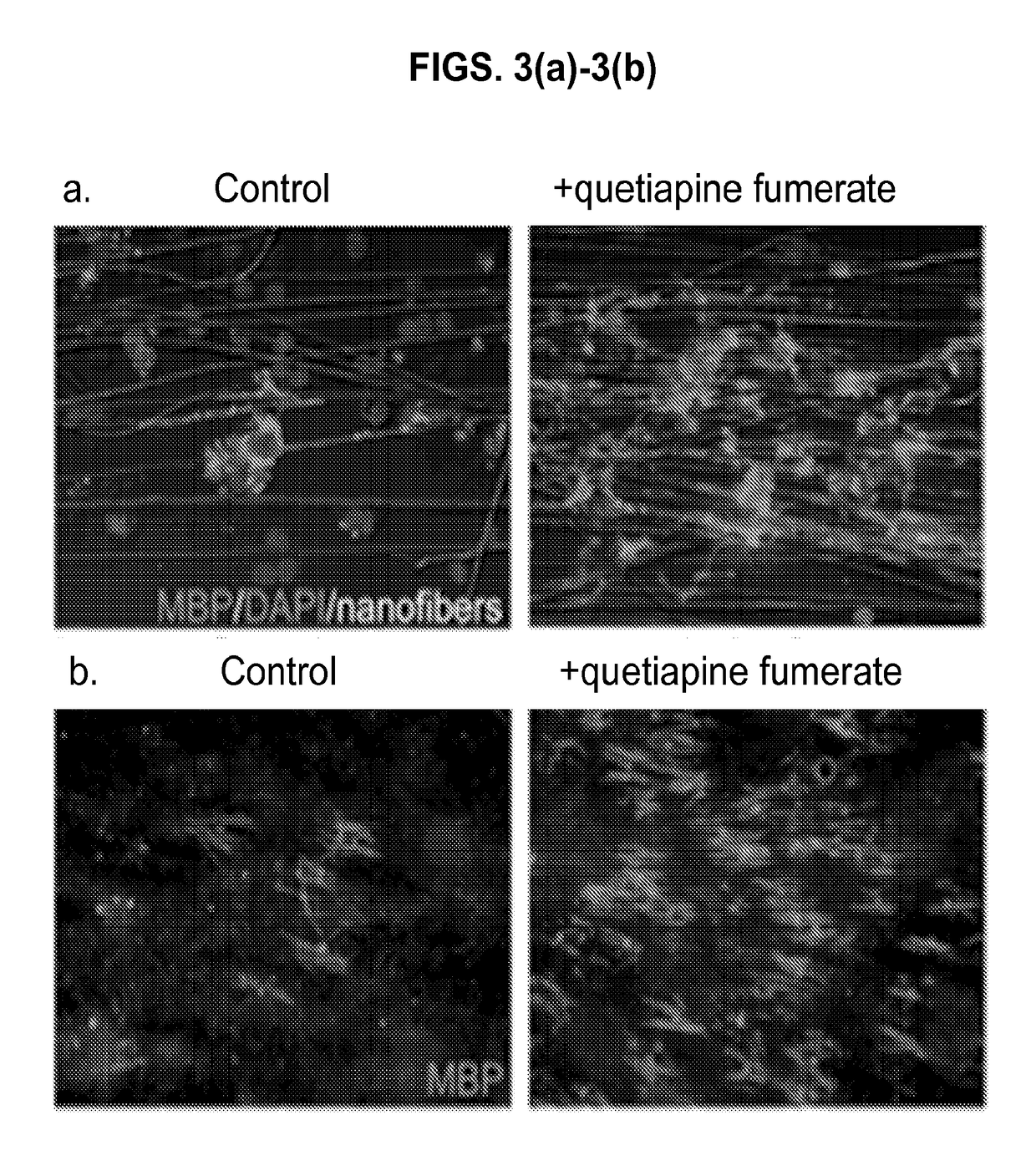Micropillar arrays for assaying myelination
a micro-pillar array and assay technology, applied in material analysis, instruments, nervous system cells, etc., can solve the problems of neuronal degeneration, neuronal degeneration, and disruption of nerve signals, and achieve the effects of neuronal degeneration, neuronal degeneration, and neuronal degeneration
- Summary
- Abstract
- Description
- Claims
- Application Information
AI Technical Summary
Benefits of technology
Problems solved by technology
Method used
Image
Examples
example 1
Nanofibres Support Myelination
[0077]It has long been thought that myelination is a result of axonal signaling to oligodendrocytes (Colello and Pott, Mol. Neurobiol. 15, 83-100, 1997). Therefore, identifying the nature of these signals is paramount to promoting repair and is indeed the goal of most myelination research. It is generally accepted that induction of myelination is somehow intimately related to axonal diameter; larger axons are myelinated while smaller ones are not. An increase in axonal target size correlates with both an increase in axonal diameter and the development of myelin (Voyvodic, Nature 342, 430-433, 1989). However, this finding alone does not establish that an increase in axon diameter is sufficient to initiate myelination, but instead demonstrates that axonal signals encourage myelin development and are regulated by extrinsic factors. Our recent findings offer an intriguing and alternative hypothesis to challenge the role of axon diameter on the initiation of...
example 2
Micropillar Arrays for Assaying Myelination
[0084]Developing a functional screen necessitates the ability to conduct experiments rapidly, in a robust, reproducible and quantitative manner. While we have clearly demonstrated that the nanofiber scaffold represents an advance in screening compounds, the fibers are not suitable for high-throughput screening. Spinning and patterning the nanofibers into small wells can only be accomplished with great difficulty and is extremely time-consuming. Additionally, automated software to identify and quantify myelin internodes is not currently available.
[0085]Micropillar arrays were fabricated from compressed silica (fabricated by Trianja Technologies). The arrays were designed on chips suitable for a 96-well format permitting for a more efficient and rapid experimental design. The micropillars allow for visualization of myelination in cross-section, a feature that will allow for the detection of “rings” of myelin (FIG. 4). As micropillars can be f...
example 3
Optimization of Micropillar Arrays
[0091]Upon further analysis of the data, we determined that the specification of the micropillar arrays needed to be altered. The first was the design in the aspect ratio of the pillars. As oligodendrocytes could not wrap the large base diameter of the pillars we decided to design the base of the pillars with a diameter of 50 μm. Maintaining a top pillar diameter of 2 μm, we decreased the height of the pillars to 25 μm to ensure the efficient ensheathment and wrapping. In order to ensure the identification of concentric wrapping of myelin membrane by oligodendrocytes we kept the gradual tapering of the pillars, as observed in FIG. 5E. The spacing of the micropillars (120 μm) was optimized to 50 μm to ensure that the number of oligodendroglial cells was matched to the density of micropillars. Finally, we patterned the array to be bonded into 96-microwell plates (FIG. 7).
[0092]FIG. 7. Optimization of BIMA design to obtain efficient ensheathment and wr...
PUM
| Property | Measurement | Unit |
|---|---|---|
| diameter | aaaaa | aaaaa |
| diameter | aaaaa | aaaaa |
| height | aaaaa | aaaaa |
Abstract
Description
Claims
Application Information
 Login to View More
Login to View More - R&D
- Intellectual Property
- Life Sciences
- Materials
- Tech Scout
- Unparalleled Data Quality
- Higher Quality Content
- 60% Fewer Hallucinations
Browse by: Latest US Patents, China's latest patents, Technical Efficacy Thesaurus, Application Domain, Technology Topic, Popular Technical Reports.
© 2025 PatSnap. All rights reserved.Legal|Privacy policy|Modern Slavery Act Transparency Statement|Sitemap|About US| Contact US: help@patsnap.com



